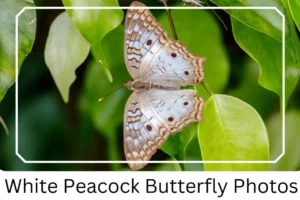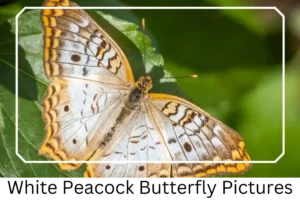White Peacock (Anartia jatrophae)
The White Peacock Butterfly, scientifically known as Anartia jatrophae, is a captivating species that graces various parts of the Americas with its presence. This butterfly is renowned for its mostly-white wings that flutter through tropical environments, exhibiting unique behaviors and adaptations that have fascinated entomologists and nature lovers alike. Its life cycle and interactions within its ecosystem offer a glimpse into the complexity of nature’s design, particularly in the way these butterflies maintain their territories and ensure the continuation of their species.

White Peacock Butterfly
Scientific Classification
- Family: Nymphalida
- Genus: Anartia
- Scientific Name: Anartia jatrophae
Overview
Embellishing the landscapes from the southern United States down to Argentina, the White Peacock Butterfly embodies the beauty and intricacy of the insect world. These butterflies navigate through life with a series of remarkable stages, from egg to caterpillar, pupa, and finally, to the adult butterfly, each phase showcasing distinct characteristics and survival strategies. The White Peacock Butterfly not only plays a crucial role in the pollination of various plant species but also adds to the biodiversity and ecological balance of its habitat.
Description and Identification
Caterpillar
The journey of the White Peacock Butterfly begins with the caterpillar, a black and spiny larva adorned with white freckles. These physical adaptations serve as both a defense mechanism against predators and a camouflage strategy. The caterpillars can reach a length of up to 4.2 cm and go through this stage for 2 to 4 weeks, feeding voraciously on their host plants.
Pupa
Transitioning into the pupa stage, the chrysalis exhibits a pale green color with small black dots, a critical period of transformation that lasts between 7 to 14 days. Within this chrysalis, the caterpillar undergoes a remarkable metamorphosis, emerging as a butterfly.
Adult Butterfly
Upon reaching adulthood, the White Peacock Butterfly showcases a spectrum of colors and patterns:
Sexual Dimorphism: Females are generally larger and have a grayer underside compared to their male counterparts.
Color and Appearance: The upper side of the open wings displays a white base with light beige to brown marks, complemented by faint cyan pigments and light crescents along the margins. The underside reveals a grayish tone with wavy orange patterns and distinctive black spots.
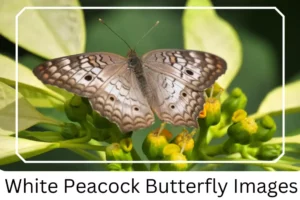
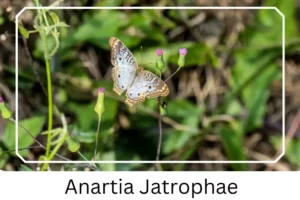 Average Wingspan: The wingspan ranges from 2 to 2¾ inches (5.1 – 7 cm), allowing for fast, erratic flight patterns.
Average Wingspan: The wingspan ranges from 2 to 2¾ inches (5.1 – 7 cm), allowing for fast, erratic flight patterns.
Flight Pattern: These butterflies are known for their quick and unpredictable flying, darting from flower to flower in search of nectar.
Eggs
The reproductive cycle continues as mature adults lay pale yellow eggs singly on the undersides of leaves, which hatch within 4 to 14 days, starting the lifecycle anew.
Quick Facts | |
| Distribution | The White Peacock Butterfly is found from the southern United States to Argentina and throughout the West Indies. |
| Habitat | Preferring open, humid areas, they thrive near streams, ponds, weedy fields, and gardens. |
| Lifespan of Adults | Adults live for 1 to 4 months, contributing to the pollination of a variety of plants. |
| Territory Size | They protect territories around their host plants, typically 15 meters in diameter. |
| Host Plants | The caterpillars feed on plants like water hyssop, ruellia, and lippie, while adults prefer nectar from lantana, bidens, and frogfruit, among others. |
| Adult Diet | They consume pollen, petals, and flower nectar, playing a vital role in the ecosystem’s health. |
How to Identify White Peacock Butterfly?
Identifying the White Peacock Butterfly in the wild involves observing several key characteristics. Look for its distinct mostly-white wings adorned with unique beige to brown markings and light crescents along the margins when the wings are open. The flight pattern is fast and erratic, a behavior that, combined with the butterfly’s sexual dimorphism, where females appear larger and grayer, helps distinguish it from similar species. The presence of circular black spots on the forewings and two on the hind wings, especially when the wings are closed, provides further identification clues. Observing these butterflies in their preferred habitats, such as gardens, parks, or near bodies of water, increases the chance of spotting and correctly identifying this stunning species.
Did You Know?
- The White Peacock Butterfly is often found basking in the sun with its wings wide open, absorbing warmth and perhaps signaling to potential mates.
- It is one of the earliest butterflies to appear in spring, signaling the change of seasons.
- The name “Peacock Butterfly” is derived from the eye spot patterns on their wings, reminiscent of a peacock’s feathers.
Conclusion
The White Peacock Butterfly stands as a symbol of beauty, adaptability, and the interconnectedness of nature. Through each stage of its life cycle, it plays a pivotal role in the pollination process and the maintenance of ecological balance. Observing and understanding the life of the White Peacock Butterfly not only enriches our appreciation for nature’s intricacies but also underscores the importance of conserving the habitats that these magnificent creatures call home.
White Peacock Butterfly Pictures
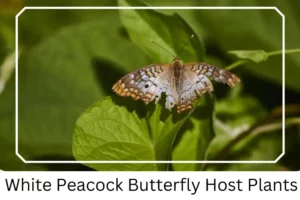
White Peacock Butterfly Host Plants

